TOVP Artwork Collection: Imagine walking through a temple where every wall sings with color, where paintings and carvings tell stories of divine love, and where art feels like a hug from the cosmos. That’s the TOVP Artwork Collection at ISKCON’s Temple of the Vedic Planetarium (TOVP) in Mayapur, West Bengal. Let’s dive into a story that’s less about paint and stone and more about devotion, creativity, and a vision that’s been centuries in the making.
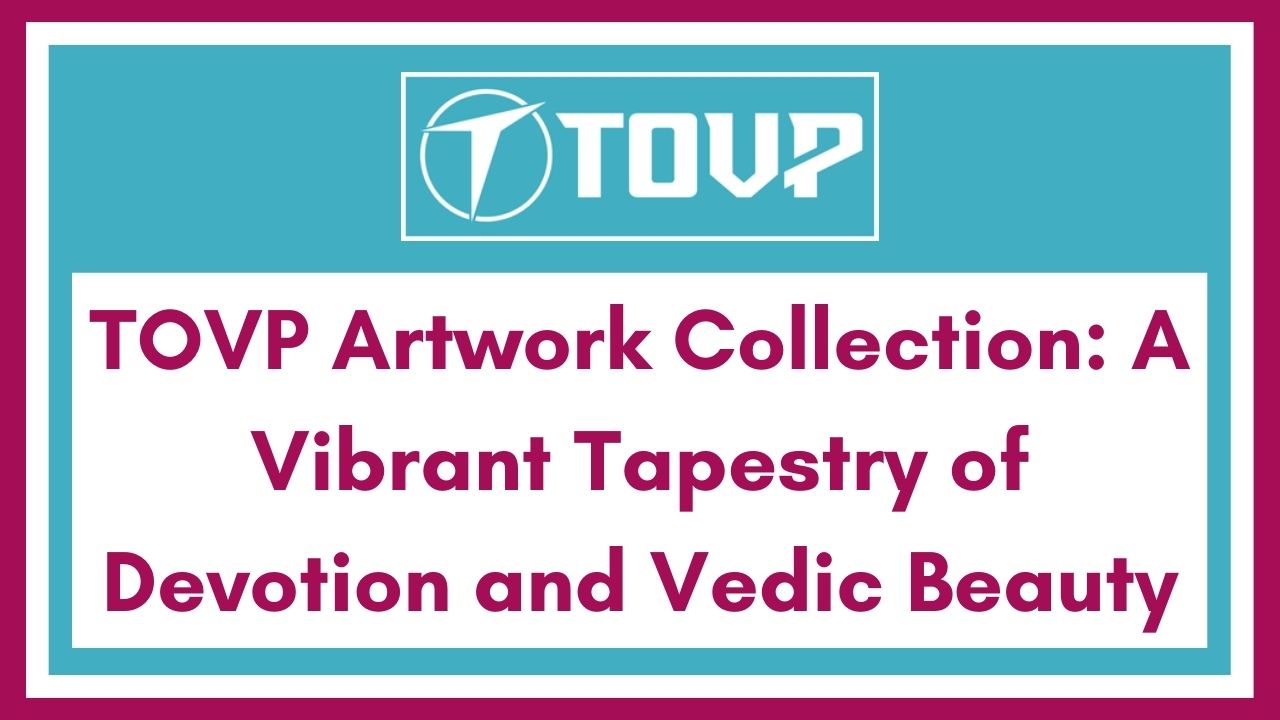
What’s the TOVP Artwork Collection?
Okay, let’s get one thing straight: the TOVP Artwork Collection isn’t just a bunch of pretty pictures hanging on a wall. It’s a vibrant showcase of Vedic art—paintings, sculptures, and carvings—that bring the stories of Krishna, Lord Caitanya, and Gauḍīya Vaiṣṇavism to life. Think of it as a visual love letter to Krishna, crafted by artists who pour their hearts into every brushstroke.
Honestly, these pieces aren’t just art—they’re portals. They pull you into a world where divinity feels as real as the ground beneath your feet.
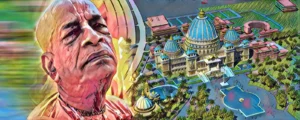
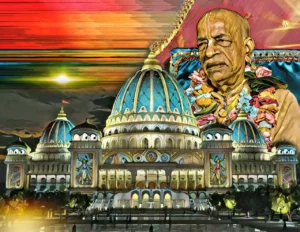
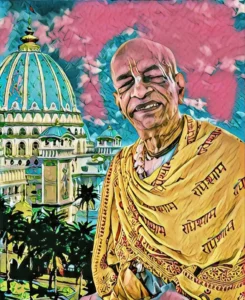

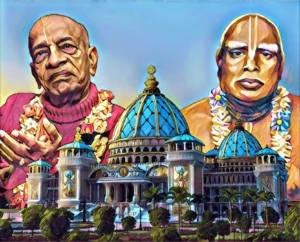
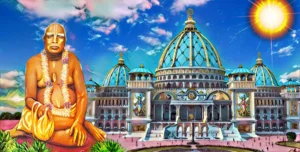



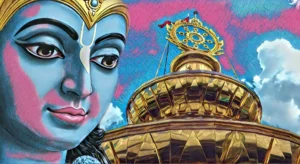
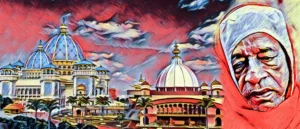
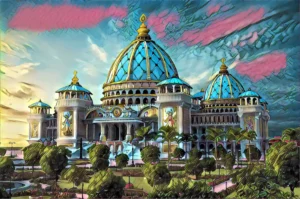
My First Brush with Vedic Art
I’ll never forget my first encounter with Vedic art at an ISKCON temple. I was staring at a painting of Krishna playing his flute, his eyes so alive I swore he was about to wink at me. That moment stuck with me, and learning about the TOVP’s artwork collection years later felt like rediscovering that magic.
It’s like the art speaks to you, whispering stories of love, adventure, and the divine. And at the TOVP, that whisper becomes a symphony.
The TOVP: A Canvas for Devotion
Before we geek out over the artwork, let’s set the stage. The TOVP, towering 113 meters in Mayapur, is ISKCON’s flagship temple, set to open in 2026. It’s not just a place for worship—it’s a global hub for Krishna consciousness, blending Vedic cosmology, architecture, and art.
Think of the TOVP as a cosmic gallery, with every corner bursting with beauty. The artwork collection? That’s the heart, beating with devotion and creativity.
Why Mayapur? Why Not a Big Art Hub?
Why showcase this epic collection in a quiet village surrounded by rice paddies? Easy: Mayapur is the birthplace of Lord Caitanya, the 15th-century saint who spread Krishna’s name like wildfire. It’s sacred ground, the perfect backdrop for art that’s all about divine connection.
Plus, Mayapur’s got this serene vibe—Ganges sunsets, kirtan in the air—that makes the artwork feel like it’s glowing from within. It’s like the universe handpicked this spot for a masterpiece.
The Paintings: A Divine Palette
Let’s start with the TOVP’s paintings. These aren’t your average canvases—they’re massive, vibrant depictions of Krishna’s pastimes, Lord Caitanya’s sankirtana movement, and scenes from the *Bhagavad Gita* and *Srimad-Bhagavatam*. Each one feels like a window into a divine realm.
I saw a preview image of a painting showing Krishna lifting Govardhan Hill, the colors so vivid it felt like the hill might float right off the canvas. These works aren’t just art—they’re storytelling at its finest.
Standout Painting Themes
- Krishna’s Lila: Scenes of Krishna herding cows, dancing with gopis, or playing his flute, bursting with color and emotion.
- Lord Caitanya’s Life: Paintings of his sankirtana missions, glowing with the energy of devotion.
- Vedic Cosmology: Artistic takes on the universe’s structure, like Mount Meru or the Brahmanda, blending science and spirituality.
- Srila Prabhupada’s Legacy: Portraits of ISKCON’s founder, capturing his vision for the TOVP.
By the way, these paintings are huge—some span entire walls. They’re designed to make you stop, stare, and maybe even tear up a little.
The Sculptures: Stone Stories
Next up, the TOVP’s sculptures. Carved from marble, sandstone, and other materials, these pieces depict deities, divine beings, and Vedic symbols with jaw-dropping detail. They’re like frozen moments of devotion, each one telling a story of love and surrender.
I heard about a sculpture of Radha and Krishna in the TOVP’s main hall, so intricate you can see the folds in their clothes and the mischief in Krishna’s smile. It’s the kind of art that makes you feel like you’re witnessing a divine dance.
Why Sculptures Hit Different
The sculptures’ 3D nature makes them feel alive, like they’re about to step off their pedestals. Photos of these pieces, especially in the TOVP’s golden light, capture a sense of eternity. They’re not just art—they’re offerings to Krishna, carved with love.
Wall Carvings: A Tapestry in Stone
Don’t sleep on the TOVP’s wall carvings. These intricate friezes, etched into the temple’s marble and sandstone, depict scenes from Krishna’s life, Vedic cosmology, and ISKCON’s history. They’re like a comic book in stone, telling stories that span millennia.
I saw a sketch of a carving showing Lord Caitanya leading a kirtan, every figure so detailed you can feel the rhythm. These carvings aren’t just decor—they’re a visual sermon.
Capturing Carvings’ Magic
The carvings’ texture and depth make them a dream for photographers. Light plays off the stone, creating shadows that add drama. Close-up shots, especially during golden hour, turn these friezes into works of art within art.
The Artists: Devotees with a Brush
Who’s behind this stunning collection? A global team of devotee-artists, many trained in traditional Vedic techniques, who see their work as an act of worship. These folks aren’t just painting or carving—they’re pouring their souls into every piece.
I met an artist in Mayapur, a quiet guy from Russia, who was working on a Krishna painting. “It’s my meditation,” he said, his hands stained with paint. That’s the spirit of the TOVP’s artwork—devotion in every stroke.
A Blend of Tradition and Innovation
The TOVP’s art draws on centuries-old Vedic styles but isn’t afraid to innovate. Some paintings use digital techniques for extra vibrancy, while sculptures blend traditional carving with modern tools. It’s like the past and present teamed up to create something timeless.
The Role of Art in Vedic Culture
Let’s get a bit philosophical. In Vedic tradition, art isn’t just for show—it’s a path to the divine. Paintings and sculptures are meant to lift your heart, focus your mind, and remind you of Krishna’s presence.
The TOVP’s artwork collection takes this to the next level. It’s like a visual kirtan, chanting Krishna’s glories through color, form, and story.
Art as Devotion
Every piece in the TOVP is an offering, created with bhakti (devotion). Artists often fast, chant, or pray before starting work, infusing their creations with spiritual energy. That’s why standing before a TOVP painting feels like a hug from the divine.
Srila Prabhupada’s Vision
Let’s rewind to the 1970s. Srila Prabhupada, ISKCON’s founder, is in Mayapur, surrounded by muddy fields and no electricity. He’s got a dream: build a temple where art and cosmology inspire the world. His disciples probably thought, “Okay, bold move!”
Prabhupada saw art as a way to share Krishna consciousness globally. The TOVP’s artwork collection is his vision in full bloom—a gallery where devotion meets beauty.
A Global Effort
Creating the TOVP’s artwork has been a massive team effort. Artists, donors, and volunteers from every corner of the globe have pitched in, from sketching designs to funding materials. I met a volunteer from Brazil who helped transport marble for sculptures. “It’s my service to Krishna,” she said, grinning.
Want to join the crew? The “Sponsor a Brick” campaign on tovp.org lets you support the TOVP, maybe even helping fund the next masterpiece.
Challenges Behind the Canvas
Let’s be real: creating this collection hasn’t been all rainbows and kirtan. Sourcing materials, coordinating global artists, and working in Bengal’s humid heat is no joke. But every challenge has been a chance to lean deeper into devotion.
I heard about an artist who spent months perfecting a carving, only for it to crack during transport. “Krishna’s teaching me patience,” he laughed. That’s the spirit behind the TOVP’s art—faith over frustration.
The Countdown to 2026
The TOVP’s grand opening in 2026 is just around the corner, and the artwork will be a star attraction. Imagine walking through halls lined with paintings, sculptures glowing in the light, and carvings telling stories of Krishna. I’m already dreaming of the photo ops!
Why the TOVP Artwork Matters
So, why care about a bunch of paintings and sculptures in a temple? Because they’re more than art—they’re a bridge to the divine, a reminder that beauty and devotion can change hearts. In a world of X scrolls and stress, the TOVP’s artwork says, “Pause. Feel. Connect.”
These pieces are for everyone—devotees, art lovers, or just curious souls. They’re an invitation to see the world through Krishna’s eyes.
A Cultural and Spiritual Showcase
The TOVP’s artwork also puts Vedic heritage on the global stage. It’ll tie into festivals, exhibitions, and talks that celebrate India’s ancient wisdom. Picture a Diwali show with paintings glowing under the TOVP’s dome—pure magic.
Plus, it’s a draw for spiritual tourists. Mayapur’s already a pilgrimage hub, and the artwork collection will make it a must-visit for art enthusiasts too.
Planning Your TOVP Art Adventure
Ready to see the TOVP’s artwork in person? Mayapur’s a 3-4 hour drive from Kolkata, through Bengal’s lush countryside. Book a guesthouse early, especially during festivals like Gaura Purnima, when the town’s buzzing like a spiritual Coachella.
Can’t make it? Check tovp.org for virtual tours, live kirtan streams, and images of the artwork. You can even donate to support the collection’s completion.
Travel Tips for Mayapur
- Best Time to Visit: November to March—cool weather, vibrant festivals.
- Dress Code: Modest clothes (cover shoulders and knees). Comfy shoes for temple wandering.
- Don’t Miss: Morning kirtan at 4:30 AM—it’s early, but the vibe’s electric.
- Foodie Tip: Grab prasad at Govinda’s restaurant. The kheer’s pure bliss.
FAQs About the TOVP Artwork Collection
What is the TOVP Artwork Collection?
It’s a vibrant showcase of Vedic art—paintings, sculptures, and carvings—at the Temple of the Vedic Planetarium, depicting Krishna’s pastimes and Vedic cosmology.
Who creates the TOVP’s artwork?
A global team of devotee-artists, trained in Vedic techniques, who see their work as an act of devotion to Krishna.
Can I see the artwork before 2026?
Limited previews are available on tovp.org, with virtual tours and images. The full collection debuts at the TOVP’s 2026 opening.
Is the artwork only for devotees?
Nope! The TOVP welcomes everyone to explore its art, whether you’re a devotee, art lover, or just curious.
How can I support the TOVP project?
Visit tovp.org to donate, sponsor a brick, or volunteer. Your contribution helps bring the artwork to life.
Join the Artistic Journey
The TOVP Artwork Collection isn’t just art—it’s a celebration of devotion, beauty, and the divine. Whether you’re standing before a painting in Mayapur or browsing images online, you’re part of this vibrant story. So, what’s next? Plan a trip, share this post, or just let the art inspire you.
Also Read:-